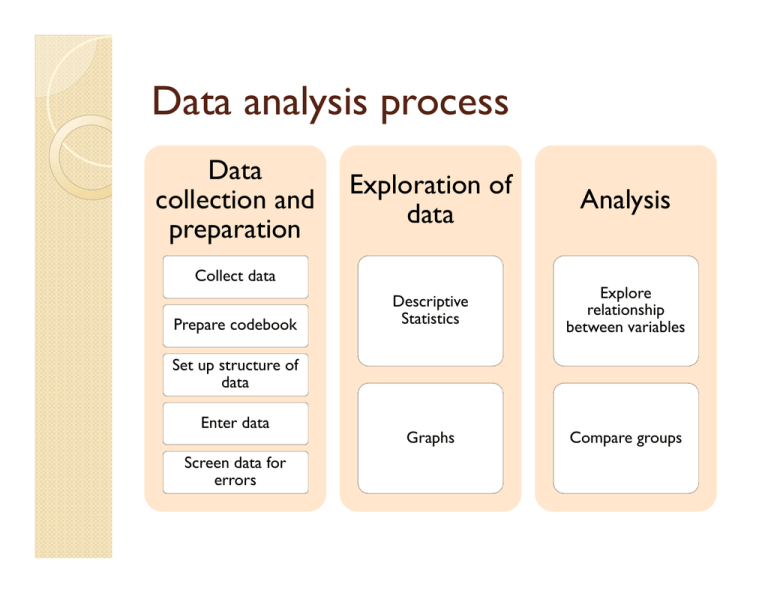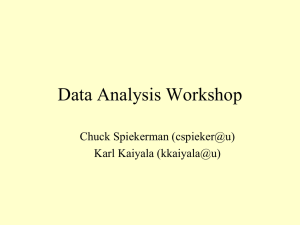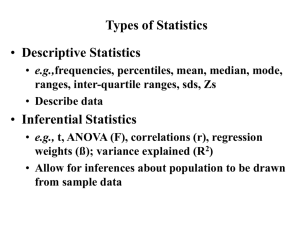Data analysis process
advertisement

Data analysis process Data collection and preparation Exploration of data Analysis Descriptive Statistics Explore relationship between variables Graphs Compare groups Collect data Prepare codebook Set up structure of data Enter data Screen data for errors Collecting data Survey Using existing data Three steps to PREPARING A DATA FILE Step 1: Setting your options: Edit>Options General tab ◦ Variable lists ◦ Output notification ◦ Calculate values immediately ◦ Display format for new numeric variables (make 0) Raise viewer window Scroll to new output ◦ Output No scientific notation ◦ Session journal Append Browse – set folder Data tab Output labels ◦ Values and labels Charts tab ◦ Formatting charts Pivot Tables tab ◦ academic Step 2: setting up the structure of the data file Variable tab – SPSS codebook Label versus name Types of variables Values of a variable Missing values Type of measurement Step 3: enter the data Data view ◦ ◦ Entering data Opening an existing data set Using Excel ◦ ◦ Variable names in the first row Converting to SPSS format Other useful things to know: Merging files ◦ Adding cases ◦ Adding variables Sorting the data file Splitting the data file Selecting cases Using sets (useful for large data files with scales) Data file information Two step to SCREENING AND CLEANING THE DATA Two steps: Step 1: checking for errors Categorical variables ◦ Analyze>descriptive statistics>frequencies ◦ Statistics: min/max Numerical variables ◦ analyze>descriptive statistics>descriptives ◦ Options: mean, std dev, min, max Step 2: finding and correcting the errors Method 1: sort cases Method 2: edit>find Other useful thing for screening Case summaries 1. Analyze>reports>case summaries 2. Choose variables, limit cases to first 100 3. Statistics: number of cases 4. Options: uncheck subheadings for totals Data analysis process Data collection and preparation Exploration of data Analysis Descriptive Statistics Explore relationship between variables Graphs Compare groups Collect data Prepare codebook Set up structure of data Enter data Screen data for errors Descriptive statistics and graphs EXPLORATION OF DATA Descriptive statistics Categorical: Frequencies Numerical: Descriptives: mean standard deviation minimum maximum skewness (symmetry) kurtosis (peakness) Missing Data Two potential problems with missing data: Large amount of missing data – number of valid cases decreases – drops the statistical power 2. Nonrandom missing data – either related to respondent characteristics and/or to respondent attitudes – may create a bias 1. Missing Data Analysis Examine missing data By variable By respondent By analysis If no problem found, go directly to your analysis If a problem is found: Delete the cases with missing data Try to estimate the value of the missing data Amount of missing data by variable Use Analyze > Descriptive Statistics > Frequencies Look at the frequency tables to see how much missing If the amount is more than 5%, there is too much. Need analyze further. Missing data by respondent 1. 2. 3. 4. 5. 6. 7. 8. Use transform>count Create NMISS in the target variable Pick a set of variables that have more missing data Click on define values Click on system- or user-missing Click add Click continue and then ok Use the frequency table to show you the results of NMISS Missing data patterns Use Analyze>descriptive statistics>crosstabs Look to see if there is a correlation between NMISS (row) and another variable (column) Use column percents to view the % of missing for the value of the variable What to do about the missing data? Proceed anyway In SPSS Options: ◦ Exclude case listwise – include only cases that have all of the variables ◦ Exclude cases pairwise – excludes only if the variables in the analysis is missing ◦ Replace with mean – use at your own risk Assessing Normality Skewness and kurtosis Using Explore: ◦ ◦ ◦ ◦ ◦ Dependent variable Label cases by – id variable Display – both Statistics – descriptives and outliers Plots – descriptive: histogram, normality plots with test ◦ options – exclude cases pairwise Outliers 1. histogram 2. boxplot Other graphs Bar charts Scatterplots Line graphs Manipulating data Recoding Calculating When to create a new variable versus creating a new one. Data analysis process Data collection and preparation Exploration of data Analysis Descriptive Statistics Explore relationship between variables Graphs Compare groups Collect data Prepare codebook Set up structure of data Enter data Screen data for errors Analysis Explore relationships among variables Compare groups • • • • • Crosstabulation/Chi Square Correlation Regression/Multiple regression Logistic regression Factor analysis • Non-parametric statistics • T-tests • One-way analysis of variance ANOVA • Two-way between groups ANOVA • Multivariate analysis of variance MANOVA Crosstabulation Aim: for categorical data to see the relationship between two or more variables Procedure: ◦ ◦ ◦ ◦ Analyze>Descriptive statistics>Crosstab Statistics: correlation, Chi Square, association Cells: Percentages – row or column Cluster bar charts Correlation Aim: find out whether a relationship exists and determine its magnitude and direction Correlation coefficients: Pearson product moment correlation coefficient Spearman rank order correlation coefficient Assumptions: relationship is linear Homoscedasticity: variability of DV should remain constant at all values of IV Partial correlation Aim: to explore the relationship between two variables while statistically controlling for the effect of another variable that may be influencing the relationship Assumptions: same as correlation c a b Regression Aim: use after there is a significant correlation to find the appropriate linear model to predict DV (scale or ordinal) from one or more IV (scale or ordinal) Assumptions: sample size needs to be large enough multicollinearity and singularity outliers normality linearity homoscedasticity Types: standard hierarchical stepwise IV1 IV2 DV IV3 Logistic regression Aim: create a model to predict DV (categorical – 2 or more categories) given one or more IV (categorical or numerical/scale) Assumptions: sample size large enough multicollinearity outliers Procedure note: use Binary Logistic for DV of 2 categories (coding 0/1) use Multinomial Logistic for DV for more then 2 categories Factor analysis Aim: to find what items (variables) clump together. Usually used to create subscales. Data reduction. Factor analysis: exploratory confirmatory SPSS -> Principal component analysis Three steps of factor analysis Assessment of the suitability of the data for factor analysis 2. Factor extraction 3. Factor rotation and interpretation 1. 1. Assessment of the suitability Sample size: 10 to 1 ratio 2. Strength of the relationship among variables (items) – Test of Sphericity 3. Linearity 4. Outliers among cases 1. Step 2. Factor extraction 1. 2. 3. 4. Commonly used technique principal components analysis Kaiser’s criterion: only factors with eigenvalues of 1.0 or more are retained – may give too many factors Scree test: plot of the eigenvalues, retain all the factors above the “elbow” Parallel analysis: compares the size of the eigenvalues with those obtained from randomly generated data set of the same size Step 3: factor rotation and interpretation 1. Orthogonal rotation 1. uncorrelated 2. Easier to interpret 3. Varimax 2. Oblique rotation 1. Correlated 2. Harder to interpret 3. Direct Oblimin Checking the reliability of a scale Analyze>Scale>Reliability Items Model: Alpha Scale label: name new subscale to be created Statistics: ◦ descriptives: item, scale, scale if item deleted ◦ Inter-item: correlations ◦ Summaries: correlations Analysis Explore relationships among variables Compare groups • • • • • Crosstabulation/Chi Square Correlation Regression/Multiple regression Logistic regression Factor analysis • • • • • Non-parametric statistics T-tests One-way analysis of variance ANOVA Two-way between groups ANOVA Multivariate analysis of variance MANOVA Nonparametric tests Non-parametric techniques Parametric techniques Chi-square test for goodness of fit None Chi-square test for independence None Kappa measure of agreement None Mann-Whitney U Test Independent samples t-test Wilcoxon Signed Rank Test Paired samples t-test Kruskal-Wallis Test One-way between groups ANOVA Friedman Test One-way repeated measures ANOVA T-test for independent groups Aim:Testing the differences between the means of two independent samples or groups Requirements: Assumptions: Procedure: ◦ Only one independent (grouping) variable IV (ex. Gender) ◦ Only two levels for that IV (ex. Male or Female) ◦ Only one dependent variable (DV - numerical) ◦ Sampling distribution of the difference between the means is normally distributed ◦ Homogeneity of variances – Tested by Levene’s Test for Equality of Variances ◦ ◦ ◦ ◦ ◦ ANALYZE>COMPARE MEANS>INDEPENDENT SAMPLES T-TEST Test variable – DV Grouping variable – IV DEFINE GROUPS (need to remember your coding of the IV) Can also divide a range by using a cut point Paired Samples T-test Aim:used in repeated measures or correlated groups designs, each subject is tested twice on the same variable, also matched pairs Requirements: ◦ Looking at two sets of data – (ex. pre-test vs. post-test) ◦ Two sets of data must be obtained from the same subjects or from two matched groups of subjects Assumptions: ◦ Sampling distribution of the means is normally distributed ◦ Sampling distribution of the difference scores should be normally distributed Procedure: ◦ ANALYZE>COMPARE MEANS>PAIRED SAMPLES T-TEST One-way Analysis of Variance Aim: looks at the means from several independent groups, extension of the independent sample t-test Requirements: ◦ Only one IV (categorical) ◦ More than two levels for that IV ◦ Only one DV (numerical) Assumptions: Procedure: ◦ The populations that the sample are drawn are normally distributed ◦ Homogeneity of variances ◦ Observations are all independent of one another ANALYZE>COMPARE MEANS>One-Way ANOVA Dependent List – DV Factor – IV Two-way Analysis of Variance Aim: test for main effect and interaction effects on the DV Requirements: ◦ Two IV (categorical variables) ◦ Only one DV (continuous variable) Procedure: ANALYZE>General Linear Model>Univariate Dependent List – DV Fixed Factor – IVs MANOVA Aim: extension of ANOVA when there is more than one DV (should be related) Assumptions: sample size normality outliers linearity homogeneity of regression multicollinearity and singularity homogeneity of variance-covariance matrices Data analysis process Data collection and preparation Exploration of data Analysis Descriptive Statistics Explore relationship between variables Graphs Compare groups Collect data Prepare codebook Set up structure of data Enter data Screen data for errors THANK YOU!




